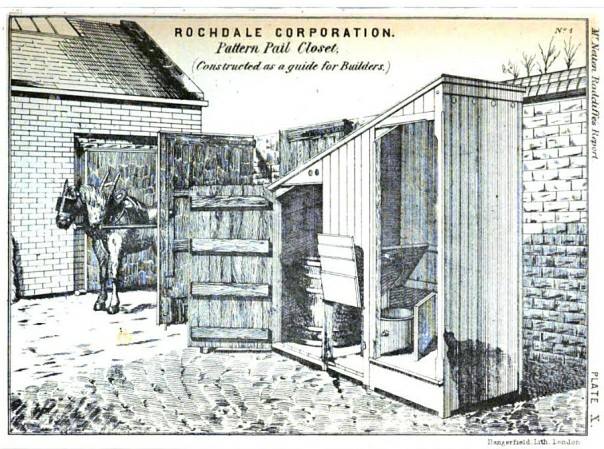The Pail Closet

Rochdale is famous for many things, for Gracie Fields and for the Rochdale Pioneers to name only
two. However, it is with a less attractive but nonetheless necessary domestic institution that
Rochdale gave its name, the Pail closet, also known as the ‘Rochdale system’.
There were a number of ways in which human waste was disposed of in the 19 th century including
the dry earth system and the midden or privy midden. By the 1860’s Manchester had 10,000 flush
toilets but more than 38,000 middens which were sometimes no more than a hole in the ground, a
dunghill or an ash pit. Sometimes called Lancashire middens, they held particular dangers to the
public. Not only did they overflow and cause river pollution but they were one of the main reasons
typhoid became a killer in society, particularly amongst the working class. Developments such as
ventilation shafts and deodorising mixtures made middens a little more hygienic and less of an
immediate danger to public health but they were difficult to empty and clean so an alternative was
sought.
Wealthier homes had flush toilets (usually outside the house) but the lack of effective water supply
meant that for many working people in heavily built-up areas waste had to be dealt with as it was or
‘by dry conservancy’. Rochdale Corporation looked at the French Goux system which was used in
Halifax whereby waste materials were absorbed by straw, grass or cotton mixed with a chemical
compound which broke it down before land disposal or conversion into compost. Instead, in 1869
Rochdale chose the Pail Closet system which was created in 1868 by Edward Taylor, a local
pharmacist with a shop on Yorkshire Street who had a sense of urgency about the health
consequences of poor water supply and the disposal of waste in the town. Furthermore, he had
advanced ideas on how to turn human waste to profit. In his system, an outside toilet or closet
contained a seat under which stood a wooden 10 gallon pail or bucket at the bottom of which would
be left one sixteenth of an inch of disinfectant or ashes. An air-tight lid on the bucket made for ease
of removal. According to records in 1871 the full pails were removed once a week.
By April of 1869 100 pail closets had been set up in Rochdale. The waste, sometimes known as ‘night
soil,’ was mixed with half a pint of antiseptic fluid then taken away under the auspices of the
Scavenging Department on a 24-bay wagon to a building near the railway station but later to a depot
on Entwistle Road which became known as the Manure Works. A replacement pail was left behind in
the closet. By 1874 Rochdale had five of these wagons collecting over 3000 buckets on a weekly
basis across the town and by 1876 this number had grown to 5000 serving over 300 closets.
On reaching the depot the wagons would empty the night soil into storage tanks whilst the pails
were washed and chlorinated. The dried waste was then either burnt or developed – with the
addition of fine ash – into fertilizer which was sold to local farmers at £6 10 shillings a ton. This early
process of re-cycling of human excrement for agricultural purposes had been discussed for decades
but never implemented. Records show that 9000 tons of waste was removed from the toilets of
Rochdale each year and whilst every effort was to make the system as hygienic as possible, Rochdale
people often complained about the smells, especially in difficult winter conditions when the wagons
couldn’t always get round.

Whilst we, with our modern drainage systems and our water supplies might blanche at such
primitive systems, the Rochdale Pail system was an improvement on the middens and must have
seemed quite hygienic compared with what had gone before. Opinions differed as to the
effectiveness of the Rochdale system, Henry Roberts in 1873 writing that it failed the first sanitary
laws in that it distributed rather than confined the smells. Others such as J R Heape, Rochdale’s
Mayor in 1888, commented that the system had brought ‘comfort and health to the town.’
Gradually Rochdale’s drains and water supplies were improved and by the beginning of the 20 th
century the Pail system or the Rochdale System was replaced by the water closet and flushing
mechanisms. The Rochdale system is, however, still used in some parts of the world, notably in
Australia where the ‘dunny’ has achieved something of comic celebrity.
Although Rochdale was visited by many from around the globe in the 19 th century to evaluate the
system’s effectiveness, it was not taken up universally possibly because of its substantial cost to
small towns. Larger towns, however, such as Wakefield, Salford, Leeds and Huddersfield did take on
the Rochdale system and whilst it had its faults and dangers to public health it was a step on the way
to transforming the handling of human waste to the system we know today.